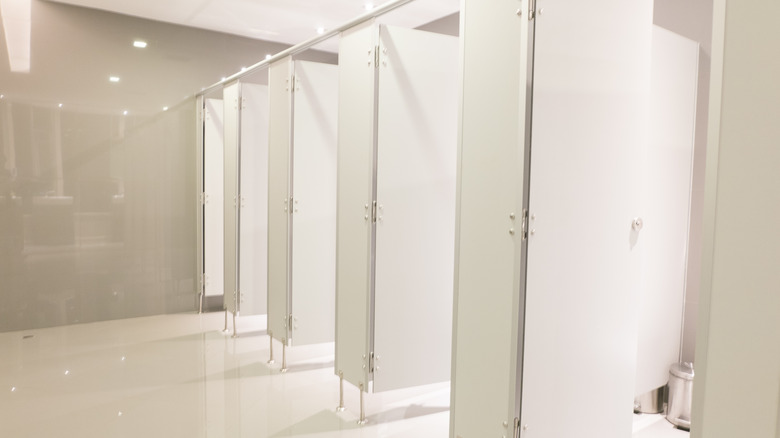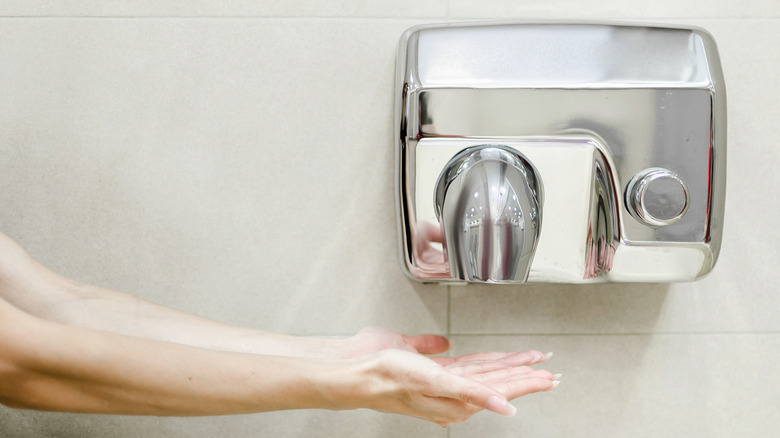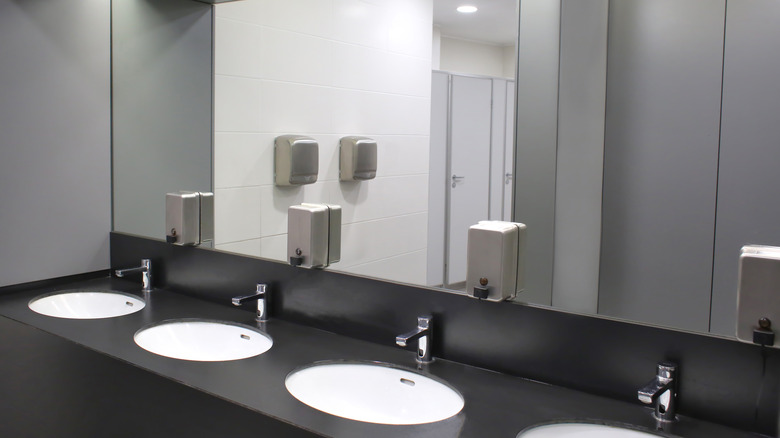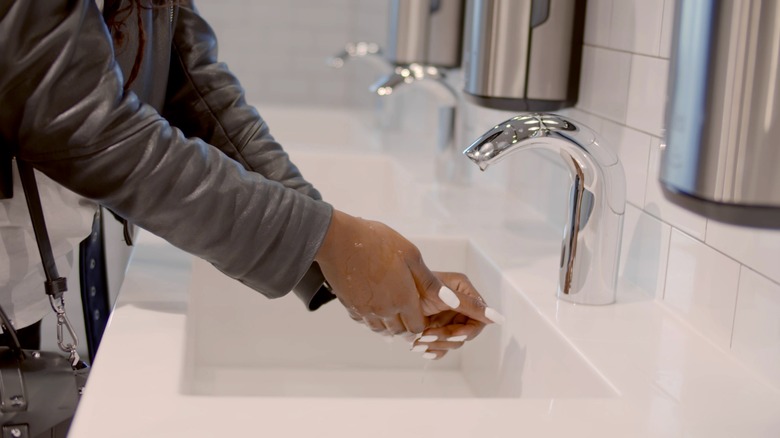The Only Stall You Should Be Using In A Public Restroom
Many of us try our best to avoid using public restrooms. You never quite know what you'll find. In an effort to maintain cleanliness, we do our best to try and pick the cleanest stall with the lowest risk of stumbling upon something gross. But in a row of stalls that look identical to one another, which do you pick? According to research, human psychology plays a large role in our preferences and when given an assortment of similar items, studies indicate that people tend to choose those in the center. Therefore, it's the middle bathroom stall that gets the most amount of action ... so to speak.
According to Business Insider, a study published in the journal Psychological Science examined the behaviors of local beachgoers in one California public restroom. Over the course of roughly two and a half months, the study monitored how quickly toilet paper ran out across four stalls in order to determine which of the stalls was most frequently used. Turns out, 60% of empty rolls were found to be located in the middle stalls, while only 40% of rolls needed changing in the end stalls. Even more interesting, in a New York Magazine survey, this preference for the middle stall proved true across both men and women (via CleanLink).
Can stall selection reduce your chance of contracting germs?
So why do we tend to gravitate toward the middle stall over the others? Scientists say it's due to what's called "the centrality preference" in humans. A 1998 study published in The Journal of General Psychology provided participants with three separate tasks to complete, where they were asked to select one item out of a collection of those items. These categories included highlighters, chairs, and a collage of three posters. In every scenario, the vast majority selected the middle option rather than those placed at either end, concluding that our focus of attention tends to lean towards centrality.
But does your stall selection really reduce your chances of contracting germs? You'll be relieved to know that Jack Gilbert, a microbiologist at Argonne National Laboratory in Illinois, says there's little to worry about when it comes to the cleanliness of public bathrooms. In order to thrive, bacteria needs to dwell in warm, damp environments and the dry, cold surfaces of bathroom toilets do not provide such an optimal environment. With too much oxygen exposure, this bacteria quickly dies off and therefore poses less of a risk to humans. In addition, regular hand washing helps to further diminish bacteria-related health risks (via Live Science). But of course, it never hurts to take extra precautions and avoid that middle stall whenever possible. To play it safe, CleanLink suggests using the first stall, as it proves to be used less frequently used and may be (hopefully) the cleanest.
The germiest part of a public restroom
Although the first stall tends to stay the cleanest overall, no area of a public restroom is free of germs. A 2019 study published in Antimicrobial Resistance & Infection Control tested 55 different public restrooms for the presence of pathogenic bacteria and discovered a whopping 52 species living on the various surfaces. Scarier still, more than 97% of these species were resistant to at least one of the most common antibiotic agents. Most of these bacteria were found on the paper towel dispensers and door handles of the tested bathrooms, while hot-air dryers were particularly saturated with microorganisms.
Matthew Wellock, M.D., spoke to Banner Health about the dirtiest part of a public bathroom, confirming that it is not the toilet, as many people might think. "Far more infectious are other surfaces in the stall and sink areas, including toilet tissue dispensers, sanitary napkin receptacles, and the most unsanitary surface — the floor," Wellock explained.
The reason that the floor is the dirtiest area of the room is because it tends to get neglected during sanitization procedures (via Banner Health). Alternatively, not all cleaning crews use a caustic detergent strong enough to kill the more resistant germs. If you weren't already grossed out, floors also frequently test positive for fecal matter. The takeaway from this is to never place any personal items on the floor –- instead, use the hooks on the back of the stall door or tuck your belongings under your arm until you leave.
How to stay safe from germs in a public restroom
While some public restrooms are cleaner than others, it would be inaccurate to describe them as hygienic. In fact, simply entering a public bathroom can put you at risk of contracting a bacterial or viral infection, explains OSF HealthCare. Manager of Environmental Services Pam Toppel states, "There is always an increased risk of cross-contamination in public restrooms, which in turn can increase your risk of infection from a virus or bacteria."
While Toppel advises people to avoid public restrooms whenever possible, she points out that there are ways to minimize this risk (via OSF HealthCare). For starters, you should do your business as quickly as possible and get out instead of lingering to fix up your hair or makeup. Additionally, you should always wash your hands thoroughly after using the bathroom. Once they are lathered and rinsed, you'll want to use a paper towel to turn off the faucet and to touch the door or any other surfaces on your way out. Toppel warns against using hand dryers, even if they're more environmentally friendly. "People think hot air is OK, but some germs actually thrive in the heat, and the blowing air can help circulate them," she says.
WebMD offers a few other suggestions for staying safe from germs, including using your foot to flush the toilet instead of touching the handle with your hand and never using toilet paper that isn't completely enclosed in the dispenser.




